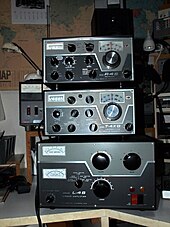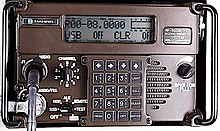Swiss embassy radio
The Swiss Embassy Radio (BF) operated a global shortwave radio network for the benefit of the Federal Council , which ensured communication between selected Swiss embassies and the government in Bern independently of the means of public communication. At times, up to 70 embassies were equipped with the shortwave radio system.
On September 11, 2001, on the day of the terrorist attacks in New York , Berne was able to maintain contact with the embassy in Washington via the independent embassy radio system, even though all public communications, including satellite connections, had failed .
business
The Swiss embassy radio system was operated by the radio service of the Federal Department of Foreign Affairs (FDFA) and procured, installed and maintained by the EMD and later the Federal Department of Defense, Civil Protection and Sport (DDPS). For operations in exceptional circumstances, the army provided radio company 48, which was an element of transmission brigade 41 and later command support brigade 41 . The Fk Kp 48 was responsible for the operation of the replacement center in the Alps and later the use of the mobile "Rapid Deployment Stations" (RDS). The radio company also supported the testing of new radio systems.
Morse code telegraphy was used for the transmission of messages until the 1970s . This required trained radio operators on all wards. Morse telegraphy was replaced by ARQ teletype systems and the BF-Syst-98 transmitted e-mails .
History of the embassy radio system
Technical development
The Swiss embassy radio started installing shortwave equipment in Vichy in 1941 and in Berlin in 1944 . In 1957, the embassy radio system was expanded into a network consisting of a central station in the Federal Palace, 11 embassies in Europe and an embassy in the Middle East under the project name Orange . The following devices were used in this system:
- Shortwave Receiver: US Signal Corps BC-342-N
- Transmitter: Hallicrafters HT-20/100 W
- Marine station: Receiver + transmitter of marine radio AN / FRC-1 (RT-16 / FRC-1)
From 1957 to 1976 the EDA radio service operated a central station in Aegerten near Kernenried . During this time the following devices were used:
- Shortwave receiver: Hammarlund HQ-150
- Shortwave Receiver: Collins 51J-4
- Transmitter: BBC (Brown Boveri) 300 W resp. 1000 W (from the former Radio Schweiz AG)
and from 1960 to 1984 KW receivers 51J-4 were purchased from Collins . In 1963 the radio service received the first LogPer antenna LP-1007 from HyGain
Between 1968 and 1971 35 radio teleprinter stations were procured. They were:
- Receiver: Collins 51J-4 and Siemens E-401
- Transmitter: Siemens S654 1 kW
- Telegraph: Siemens T-100, Tsend, Tloch.
- Reception error correction by the punched tape comparison device STREIKO from Siemens-Albis Zurich.
- DRAKE transmitters and receivers: R-4B, T-4XB and linear amplifier L4-B (1 kW)
The inauguration of the new Mittelland transmission system in Aegerten near Kernenried took place in March 1972. From 1974 to 1984 the FSK-F-6 began operating with "time diversity". The message, transmitted twice with a time delay, generated two receiving pinstripes. The messages were compared with a punched tape comparator. If anything was unclear, another broadcast of the same message had to be arranged. With the total of four punched strips, the final content could be generated with the majority decision. Some F-6 radio systems were installed as mobile stations in Berna trucks.
The embassy in London was the first remote station to be equipped with an F-6 radio teletype system in 1974. The S-654 tube transmitter from SIEMENS with an HF output of 1 kW was used here. In 1976, the embassy radio received a new Mittelland headquarters. The reception systems were installed in Murain near Ersigen and the transmitters in Kernenried, six kilometers to the southwest . The radio service of the EDA and the embassy radio section of the EMD / VBS were based in Murain. The transmitters were remote-controlled from Murain via a cable. From the Mittelland headquarters until 1983, among other things, traffic to Panmunjom in Korea via Tokyo , Bangkok and New Delhi was handled.
1979 created the transmission brigade 41 the BF company (Fk Kp 48). In the same year, the Klewenalp transmitter (KLE) was opened with two MARCONI H-1200 transmitters with an output of 10 kW and a frequency range of 3–27 MHz. This system was remotely controlled by the Murain central office. First two wire LogPers Granger LP-1730 ![]() and later two LogPers LP-1001 from HyGain were used as antennas.
and later two LogPers LP-1001 from HyGain were used as antennas.
In 1972 a temporary replacement center came into operation in a former artillery installation on the Jaunpass . The temporary solution was replaced in 1983 with the construction of a replacement center in the Alpine region. It comprised a reception system in Eggli (EGG) near Gstaad and a transmission system in Sparenmoos (SPA). The new headquarters started operations in 1985.
In 1984 ARQ technology was introduced with System 90 from the Swedish company SRT Standard Radio & Telefon AB . The general contractor was the Swiss company STR in Zurich. The devices used were:
- TD 90 exciter
- Receiver CR 91
- Channel selector CH 91
Some so-called "heavy radio teleprinter" (SF) continued to use the 1 kW Siemens power amplifier. The light radio teleprinter station LF used the transistor transmitter SSA400 with an HF output of 400 W. At the same time, the transistor transmitter SSA1000 with an HF output of 1 kW was used in the inland control centers. The channel selector enabled the channel to be called up with automatic station tuning on 99 channels. This replaced the previous manual operation and simplified operation of the radio station. The electronic teleprinter PACT 220 from Philips-Sweden and the data radio modem SITOR STB-750 MkII from Philips-Holland enabled telegram traffic with automatic ARQ error correction. A scanner workstation in the Murain headquarters and in the New Delhi transit station made it possible to establish an automatic connection without any operation in the headquarters. When the network was completed, it comprised 70 international stations.
From 2001 onwards, some of the agencies were equipped with the new BF-Syst-98 radio message system. This system delivered emails . The BF-Syst-98 devices came from HARRIS RF Systems in Rochester (New York) . Ascom Systec in Hombrechtikon was the general contractor . The US standards MIL-STD-188-141 and FED STD 1052 served as the transmission method. When the connection was established, all programmed channels were tried out in a three-way handshake with the other station and the quality was saved in a table. The transmission then took place on the channel with the best quality.
The heart of the system was the Harris transceiver RF-5022 RT-E with an output power of 100 mW. The transceiver belongs to the Harris FALCON Series II. All radio stations had a modern 1 kW transmitter with automatic frequency tuning. In 2011 the network consisted of 26 international stations, 6 mobile rapid deployment stations in containers and 6 domestic systems. Two of the six mobile stations were in use at Swisscoy in Sarajevo .
The BF-Syst-98 did not need any radio operators, which led to the dissolution of the EDA radio service. The system was maintained by the War Material Administration (KMV) and later RUAG . The building maintenance of the inland facilities was carried out by the fortress guard corps (FWK) and the logistics base of the army (LBA).
Encryption
Various systems were used to encrypt the texts to be transmitted.
- 1941-1944: Enigma-K
- until 1974: NEMA , a further development of the German Enigma encryption machine. The NEMA was built by the Zellweger AG company in Uster.
- 1974-1991: TC-850
- From 1991: TC-91 from Omnisec.
- BF-Syst-98: TC-91 and TC-007
Shutdown of the embassy radio network
In 2014, the main user EDA could not agree with the DDPS on assuming a larger share of the costs than before, and so the Federal Council decided to release the management support base from the task of operating the embassy radio. Operations ceased at the beginning of January 2015. The Federal Council had given up its crisis-proof connection with its representations abroad, which was independent of third parties.
Embassy Radio Museum
The Embassy Radio Museum is located in the Dailly fortress above Saint-Maurice in the Rossignol gallery . The museum is part of the historical exhibition of the fortress military switchboards and fortress dioramas of the Association Saint-Maurice d'Etudes Militaires (ASMEM).
In 2015, the Foundation for Historical Army Material Command Support added two fully equipped and functioning embassy radio systems in shelters to its collection.
Embassy radio radio amateurs
The association "Embassy Radio Radio Amateurs" was founded in 2004. The radio amateur - call sign of the association is HB9BF. The association's seat is in Niederteufen / AR .
Web links
Individual evidence
- ↑ See English Wikipedia article: RL Drake Company
- ↑ a b c History of the embassy radio 1941-2015 . Foundation HAMFU
- ↑ a b c Armyradio.wiki: Embassy radio
- ↑ EMD = Federal Military Department
- ↑ Pdf document: Transmission Brigade 41 .
- ↑ Description of the Hammarlund HQ-150 receiver .
- ↑ HAMFU: Description of the Collins 51J-4 receiver .
- ↑ See Wikipedia article: Hy-Gain Antennas and Rotators
- ↑ Description of the E401 receiver from Siemens
- ↑ Description of the Siemens S654 power amplifier .
- ↑ See English Wikipedia article: RL Drake Company
- ↑ Description of the LP-1001
- ↑ See English Wikipedia article: Standard Radio & Telefon AB
- ^ Philips: Pact 220 .
- ↑ Information technology and the army. ETH division: Embassy radio with modern shortwave technology
- ↑ See Wikipedia article: Harris Corporation
- ↑ Harris website
- ↑ Harris_FalconII RF-5000 HF Long Range Tactical Radio_Datasheet
- ↑ A. Hildebrandt, C. Brunisholz: The history of the war material administration KMV. L'histoire de l'Intendance du matériel de guerre IMG. 1850-1975 . 1977.
- ↑ HAMFU: Description of the Nema .
- ↑ See English website: Omnisec Cryptomuseum .
- ↑ homepage ASMEM







